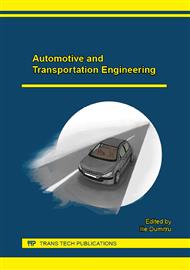p.311
p.321
p.331
p.341
p.346
p.354
p.360
p.365
p.375
Considerations Regarding Validation through Simulation of Some Board System Information’s for Powertrain Performance Optimization
Abstract:
The authors present in this paper the opportunities offered by the use of software platforms (MULTISIM) in the validation of informational systems for optimizing economical consumption. So after some research (based on identification methodology system type) a physical-mathematical model can be developed that offers the possibility to optimize fuel consumption in the economy pole depending on specific correlations of operating regimes. Resulted relationships allow designing of information systems by proposing solutions which acquire information on movement speed, engine RPM in load (by determining the actual torque through correlations of exhaust gas temperature, moment and torque).Having these relationships we can design, for example, system version with discrete components or with digital system for surveillance engine operation.
Info:
Periodical:
Pages:
346-353
Citation:
Online since:
January 2016
Authors:
Keywords:
Price:
Сopyright:
© 2016 Trans Tech Publications Ltd. All Rights Reserved
Share:
Citation:


